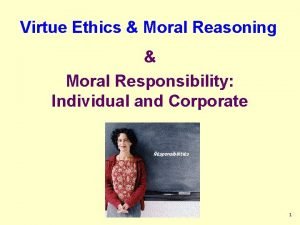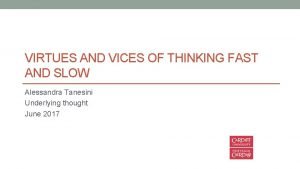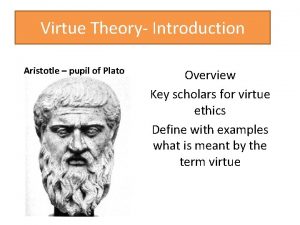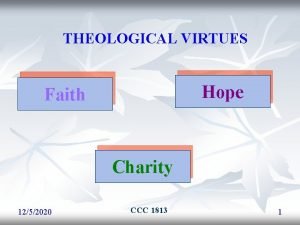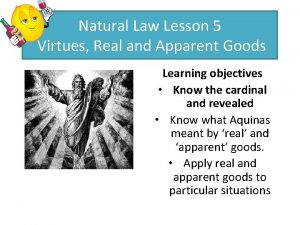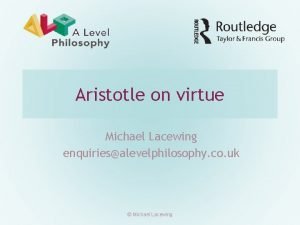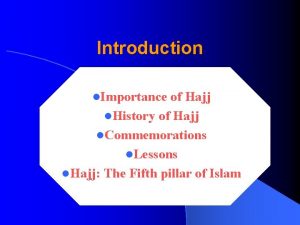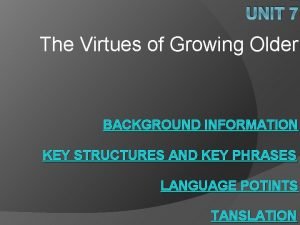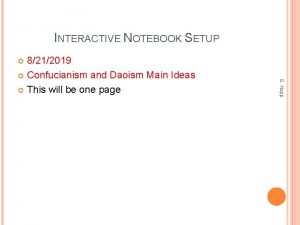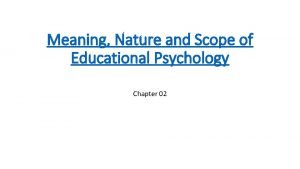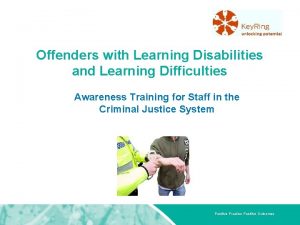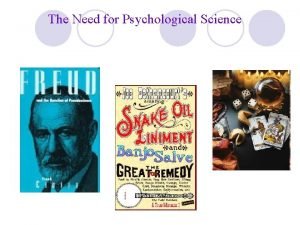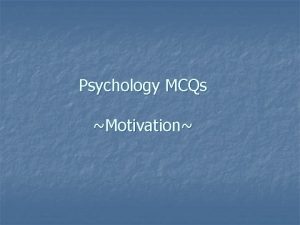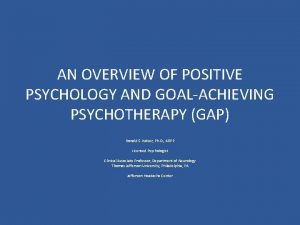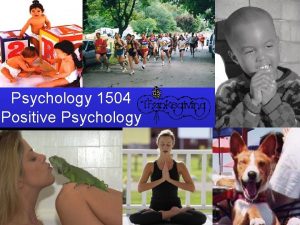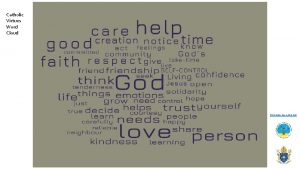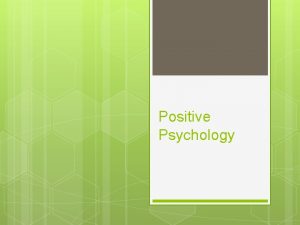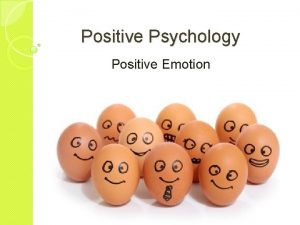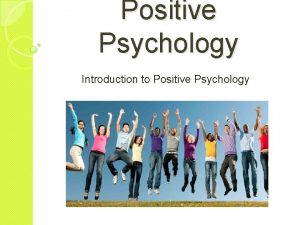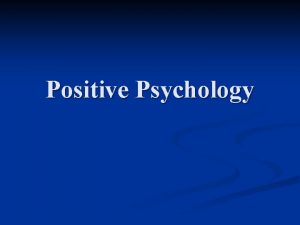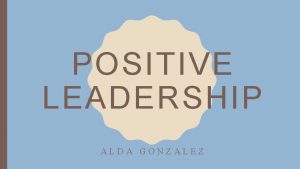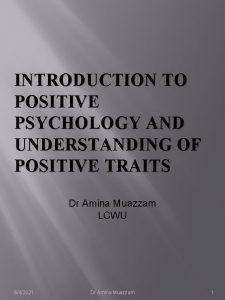Positive Psychology and virtues of Positive Psychology Dr






































- Slides: 38

Positive Psychology and virtues of Positive Psychology Dr Amina Muazzam. . . LCWU 9/14/2021 1

Dr Amina Muazzam. . . LCWU 9/14/2021 2

Introduction Positive psychology , a new domain of psychology introduced by Seligman. Positive psychology is concerned with factors that lead to a fulfilling life. Psychology is not just the study of pathology, weakness and damage; it’s also the study of strength and virtue. Health Psychology and positive psychology share much in common, health psychologists have long suspected that negative emotions can make us sick and positive emotions can be beneficial. Positive Psychology defined as a study of optimal human functioning, focusing on the conditions and processes that contribute to the flourishing of people, groups, and institutions, as well as on the understanding and facilitation of their positive developmental outcomes. Positive psychology has made a notable change in psychology, diverting the psychologists’ attention from maladaptive behaviour, negative thinking and mental suffering to well-being and other factors that make our life worth living. Dr Amina Muazzam. . . LCWU 9/14/2021 3

The positive aspects of life is definitely not a modern invention The two primary ancient constructs are Aristotle’s eudaimonia. Maslow was the first person to coin the term “positive psychology” Carl Rogers (1961), one of the founders of humanistic psychology, who came up with the concept of a fully functioning person. Dr Amina Muazzam. . . LCWU 9/14/2021 4

Continued. . Viktor Frankl (1992) also gave psychotherapy which draws on man’s motivation to search for meaning (“will to meaning”). Allport (1961) who focused on personality development and maturity. Greenberger (1984), the author of a multidimensional model of psychosocial maturity in adolescents. Ryff (1989) personal growth conception in continual development, openness towards people and events and conscious expansion and improvement. Dr Amina Muazzam. . . LCWU 9/14/2021 5

The issue of life meaningfulness by a range of existential psychologists and psychotherapists including Baumeister (1991) and Yalom (1980). Huppert and So (2011) attributed ten features in their conceptualisation of flourishing: positive emotions, engagement, meaning, competence, emotional stability, resilience, optimism, vitality, self-esteem, and positive relationships. Existing research on the notion of hope shows that both hedonic and eudaimonic components of well- being significantly contribute to flourishing in life. Dr Amina Muazzam. . . LCWU 9/14/2021 6

PERMA MODEL Dr Amina Muazzam. . . LCWU 9/14/2021 7

Seligman’s PERMA model distinguishes five components of a happy and fulfilled life: Positive emotions, Engagement, Relationships, Meaningfulness, and Accomplishment. Dr Amina Muazzam. . . LCWU 9/14/2021 8

P – Positive Emotion This element of the model is one of the most obvious connections to happiness. Being able to focus on positive emotions is more than just smiling, it is the ability to be optimistic and view the past, present, and future from a positive perspective. Dr Amina Muazzam. . . LCWU 9/14/2021 9

E – Engagement It is important in our lives to be able to find activities that need our full engagement. Engagement in the activities in our lives is important for us to learn, grow and nurture our personal happiness. Dr Amina Muazzam. . . LCWU 9/14/2021 10

R – Relationships and social connections are one of the most important aspects of life. Humans are social animals that thrive on connection, love, intimacy, and a strong emotional and physical interaction with other humans. Building positive relationships with your parents, siblings, peers, and friends are important to spread love and joy. Having strong relationships gives you support in difficult times. Dr Amina Muazzam. . . LCWU 9/14/2021 11

M – Meaning Having a purpose and meaning to why each of us is on this earth is important to living a life of happiness and fulfillment. Rather than the pursuit of pleasure and material wealth, there is an actual meaning to ourlife. Such meaning gives people a reason for their life and that there is a greater purpose in life. Dr Amina Muazzam. . . LCWU 9/14/2021 12

A – Accomplishments Having goals and ambition in life can help us to achieve things that can give us a sense of accomplishment. You should make realistic goals that can be met and just putting in the effort to achieving those goals can already give you a sense of satisfaction when you finally achieve those goals a sense of pride and fulfillment will be reached. Having accomplishments in life is important to push ourselves to thrive and flourish. Dr Amina Muazzam. . . LCWU 9/14/2021 13

How to Apply the PERMA Model in Your Life Dr Amina Muazzam. . . LCWU 9/14/2021 14

Positive Personal Traits In this section we’ll briefly address five articles that deal with different personal traits that contribute to positive psychology: 1. 2. 3. 4. Subjective Well-Being Optimism Happiness Self-Determination Dr Amina Muazzam. . . LCWU 9/14/2021 15

Subjective well Being One of the leading experts of this topic is Edward Diener (2000), his work now spans more than 3 decades. Subjective well-being refers to what people think and feel about their lives – to the cognitive and affective evaluation they draw when they assess their existence. It’s the more scientific term for what people normally call happiness. Diener looked at the temperament and personality correlates of wellbeing and the demographic factors of groups high in subjective well-being. His research suggests interesting findings between macro social conditions and happiness. 16 Dr Amina Muazzam. . . LCWU 9/14/2021

Optimism Christopher Peterson (2000) described the benefits of this trait. He considered optimism to entail cognitive, emotional and motivational components. His work aims to understand the mechanisms of optimism and answer questions like: Can we increase optimism? When does it begin to distort reality? How does an overly pessimistic culture affect the well-being of its citizens? Dr Amina Muazzam. . . LCWU 9/14/2021 17

Happiness David Myers (2000) took the belief that traditional values must contain important elements of truth in order to survive across time and tested the empirical validity of this claim. He is more attuned than others in the field, to issues such as the often found association of faith with happiness. He also considered the relationship between economic growth and income and close personal relationships to happiness. His findings are a valuable resource to anyone interested in understanding the elements that contribute to a positive life. Dr Amina Muazzam. . . LCWU 9/14/2021 18

Self-Determination Richard Ryan and Edward Deci are the authors of the self-determination theory. This theory researches three related human needs: The need for competence The need for belonging The need for autonomy According to Ryan and Deci, when people meet these needs their personal well-being and their social development are optimized. When this happens, people are intrinsically motivated, able to achieve their potentialities and to seek ever expanding challenges. Dr Amina Muazzam. . . LCWU 9/14/2021 19

Dr Amina Muazzam. . . LCWU 9/14/2021 20

COMPASSION, COURAGE, RESILIENCE

Compassion Ø Compassion is a language which the deaf can hear and the blind can see. Ø Compassion motivates people to go out of their way to help the physical, mental or emotional pains of another and themselves. Ø It is actually a sympathetic pity and concerns for the sufferings or misfortunes of others.

Components of compassion Ø A sensitivity to suffering in yourself and others. Ø A commitment to try to alleviate and prevent this suffering. in both cases compassion involves courage and strength

Types of compassion Ø Familial compassion (with family) Ø Familiar compassion (friends, neighbors) Ø Stranger compassion (global compassion) Ø Salient compassion (to lower animals)

Ways of showing compassion Ø Start with yourself – praise yourself for your success and forgive yourself for your mistakes. Ø Communicate verbally and non-verbally – eye contact, active listening, paraphrasing and open-ended questions. Ø Touch (if appropriate) – a gentle and soft touch to hand or shoulder during conversation. Ø Encourage others – positive reinforcement Ø Express yourself – match the facial expressions to your felt emotions, a sincere smile and a good laugh.

Continue… Ø Show kindness – give your kindness without expecting anything back. Ø Respect privacy – be attentive to someone’s privacy. Protect their dignity. Ø Learn how to advocate – to effectively advocate you must actively listen to what your friend needs. Ø Volunteer – spending time helping people is good for your body, mind and soul. Ø Consider your words – think before you speak

Courage Ø “COURAGE IS THE FIRST OF HUMAN QUALITIES BECAUSE IT IS THE QUALITY WHICH GUARANTEES ALL OTHERS”. (Winston Churchill) Ø It is the ability to do something that frightens one. Ø It is the capacity to control your fear in a dangerous or difficult situation. Ø It is a strength to be brave and confident enough to do what you believe in.

Types of courage Ø physical courage – allows us to risk, discomfort, injury, pain, facing an enemy on the battlefield, undergoing chemotherapy etc. Ø Social courage – risk of social embarrassment, unpopularity or rejection. It also involves leadership. Helps us apologize and move on. Ø Intellectual courage – willingness to engage in challenging ideas, to question and to risk of making mistakes. Ø Moral courage – it involves doing the right thing particularly when risks involve shame, opposition or the disapproval of others. Ø Emotional courage – it opens us to feeling the full spectrum of positive emotions at the risk of encountering the negative one.

Continue… Ø Spiritual courage – attending religious gatherings, making time to pray and do some charity. Strengths associated with courage Ø Integrity (speak the truth, act sincerely, present yourself in an authentic way). Ø Bravery (speaking and acting for what you believe despite opposition) Ø Persistence (finishing what you start even in the face of resistance) Ø Vitality (entering life fully)

Traits of courageous people Ø They are realistic Ø They choose light over dark Ø They care deeply about their cause

Resilience Ø Resilience is the capacity to recover quickly from difficulties or toughness. Ø It is a sort of “miracle drug” personality trait, something that can heal all wounds and right all wrongs. Ø It is the ability and tendency to “bounce back”.

Bounce back Ø It is the process of adapting well in the face of adversity, trauma, tragedy, threats or significant sources of stress. Ø Bounce back is what we do when we face disappointment, defeat and failure but instead of letting things keep us down we get back and continue on with our lives.

The power of failure Ø The failure is the capacity to inspect and learn from. Ø Failures are stumbling blocks on the proverbial path to success. Ø The lessons they teach have implications for humility, maturity and empathy.

Characteristics of resilient people Ø A sense of control Ø Strong problem solving skills Ø Strong social connections Ø Identifying as a survivor, not a victim Ø Being able to ask for help Ø Sense of autonomy

Tips to improve resilience Ø Get connected Ø Make every day meaningful Ø Learn from experience Ø Remain hopeful Ø Take care of yourself Ø Be proactive Ø Learn to perceive obstacles as challenges rather than hindrances Ø Focus on progress, not goals Ø Practice your ABC’s

When to seek professional advice? Ø Becoming more resilient takes time and practice. If you don't feel you're making progress — or you don't know where to start — consider talking to a mental health provider. With guidance, you can improve your resiliency and mental well-being.

Resilience exercise A visualization technique that can be used for this is to imagine the place you are in at the moment and slowly zoom out of yourself. Slowly zoom out of the building you're in, of the place, of the state, country and even continent. Then you zoom out further all the way through the ozone layer until you reach the moon and are looking at the whole earth. Now think about your problem again, how big is it really?

Thank you
 What is cardinal virtues and theological virtues
What is cardinal virtues and theological virtues Positive psychology ap psychology definition
Positive psychology ap psychology definition Moral responsibility
Moral responsibility The seven heavenly virtues
The seven heavenly virtues Virtues and vices are attitudes. what are their objects?
Virtues and vices are attitudes. what are their objects? Virtue theory
Virtue theory Virtues list
Virtues list Aristotle virtues
Aristotle virtues Aristotle virtues
Aristotle virtues Bad nature
Bad nature Ccc virtues
Ccc virtues Virtue theory
Virtue theory Ten virtues mentioned in romans 12:9-21
Ten virtues mentioned in romans 12:9-21 Opposite virtues
Opposite virtues Apparent good vs real good
Apparent good vs real good Virtues vs values
Virtues vs values Etiquette of making dua
Etiquette of making dua Ethics of doing
Ethics of doing Aristotles virtues
Aristotles virtues Four cardinal virtues
Four cardinal virtues Virtues of hajj
Virtues of hajj Infused virtues
Infused virtues The twelve virtues
The twelve virtues God-given virtues that direct us to our loving, triune god.
God-given virtues that direct us to our loving, triune god. Justice new testament
Justice new testament The virtues of growing older
The virtues of growing older Cardinal virtues catholic
Cardinal virtues catholic Conscience and natural law
Conscience and natural law Confucian virtues
Confucian virtues Educational psychology and its scope
Educational psychology and its scope Mannitol fermentation
Mannitol fermentation What's 8 + 5
What's 8 + 5 Positive practice positive outcomes
Positive practice positive outcomes Examples of naturalistic observation
Examples of naturalistic observation Positive psychology mcqs
Positive psychology mcqs Computer metaphor
Computer metaphor Concepts of positive psychology
Concepts of positive psychology Positive psychology 1504
Positive psychology 1504 Strath haven positive psychology curriculum
Strath haven positive psychology curriculum


